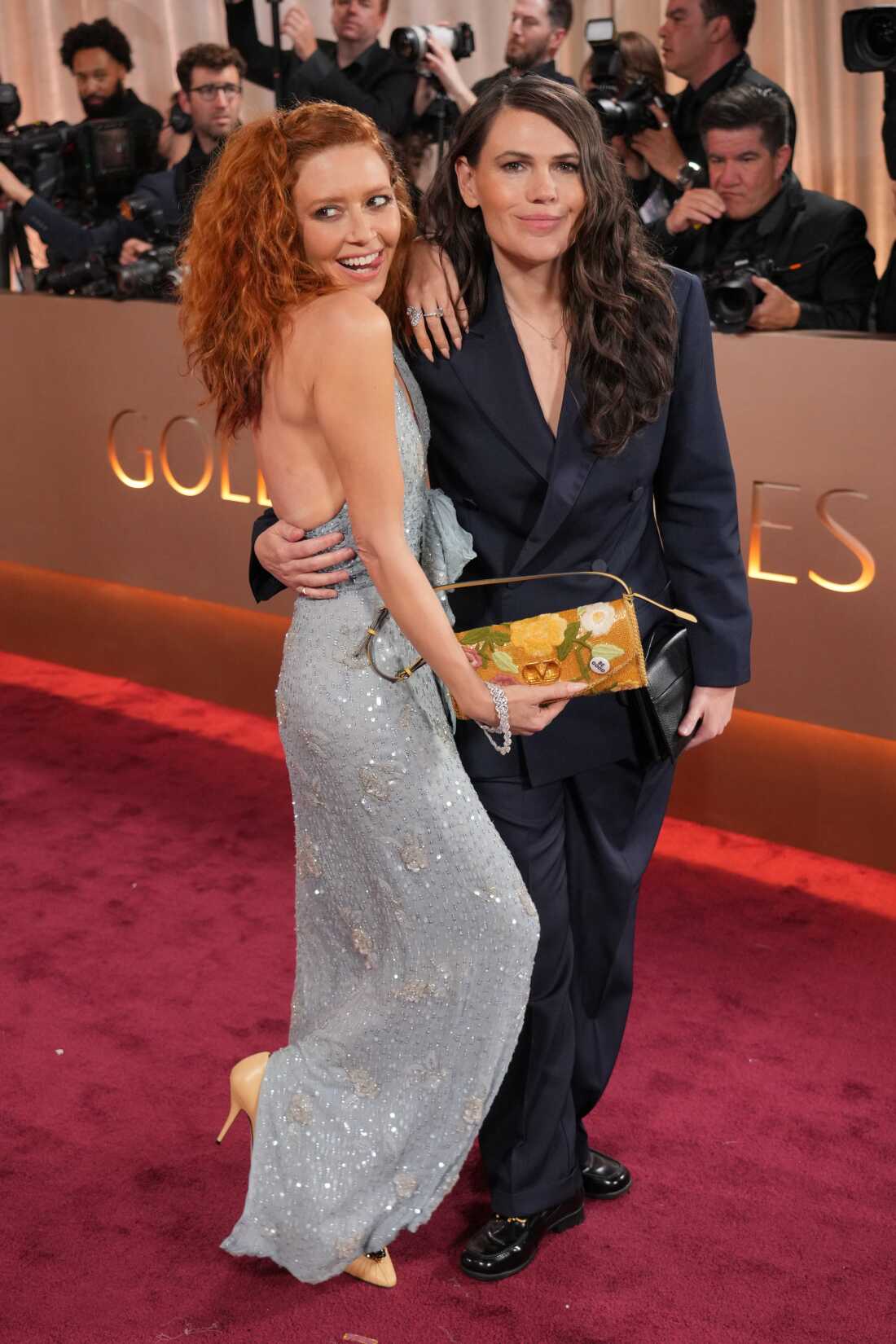Lifestyle
Taylor Swift and Travis Kelce Grab Dinner in NYC After US Open Date

Taylor Swift and Travis Kelce‘s date just keeps on rolling … the two stars just pulled up to a New York City restaurant — hand-in-hand, like we’ve seen a lot recently.
The two celebs hit a popular Mediterrean restaurant in Manhattan Sunday night… looking loved up in new outfits hours after pulling off tennis chic in Queens.
Travis dressed in a collared shirt and pants, hat on his head, while Taylor threw on a different dress for their evening meal … one a little less bright than her tennis-watching ensemble.
The two walked in, hands clasped tightly one another. No other PDA in this situation … but, it’s clear Swelce’s very happy together.
As you know … America’s favorite couple hit the men’s final of the US Open where they watched Jannik Sinner sweep Taylor Fritz.
The two were joined by close pals Patrick and Brittany Mahomes … putting rumors that Tay and Britt were beefing after Mahomes’ recent political social media activity to rest.
It’s been a Travis/Taylor filled weekend … ’cause Travis played Thursday night in front of his parents and better half — so, he had time to kill on Saturday and Sunday.
The duo pulled up to a wedding at Electric Lady Studios Saturday night, a day after chowing down on pizza — and, getting a whole lot of attention from fans.
The two are spending a ton of time together recently … since Taylor’s got a break in her “Eras” tour until the middle of October when she’ll be back onstage in Miami.
The Kansas City Chiefs play the Cincinnati Bengals in K.C. on Sunday … so Travis has got to get back to practice soon — and, ya gotta think Taylor’s getting ready for another Sunday above the gridiron.
Before that, the two can enjoy a nice meal together … and, enjoy a good night’s sleep after a very long day.

Lifestyle
Video: Fashion Highlights From the 2026 Golden Globes

new video loaded: Fashion Highlights From the 2026 Golden Globes
By Vanessa Friedman, Chevaz Clarke, Gabby Bulgarelli and Jon Hazell
January 12, 2026
Lifestyle
L.A. Times Concierge: I moved to Pasadena. Where are all the queer bars?

My husband and I live in Pasadena. We moved from Los Feliz about 10 years ago. We have struggled to find LGBTQ+ events this far east. We can only hit up Boulevard so many times (although we love it). Any advice for finding LGBTQ+ events in Pasadena, Eagle Rock, Highland Park, Glendale or the SGV? I feel like there are bars out here that may host weekly events that I just don’t hear about. — Will Birnie
Looking for things to do in L.A.? Ask us your questions and our expert guides will share highly specific recommendations.
Here’s what we suggest:
Will, you are so right. While there are several queer bars around your former neighborhood (Hi Tops in Los Feliz, Akbar in Silver Lake, Club Bahia in Echo Park and Honey’s at Star Love in East Hollywood), they are few and far between in the eastern part of L.A. County. But your question sent me down a rabbit hole and I’m proud to report that I’ve found a handful of spots and regular events that you should check out in your area. (Shout out to my colleagues and everyone who responded to my request for help on Instagram.)
Highland Park is home to the Offbeat, which is one of my friend Jaycen Mitchell‘s favorite bars in the area. The beloved dive bar hosts karaoke nights, drag shows, live music performances, “RuPaul’s Drag Race” screenings and other themed nights throughout the week. “I’ve been able to see all of my favorite drag queens there in more intimate settings, and the DJs have had me and my friends dancing until we were the last ones there,” Mitchell tells me. Also in Highland Park is Blind Barber, a speakeasy that hosts Homo Happy Hour on Thursdays. Mitchell says the happy hour is always a good time and a chance to “show up as your authentic self, be in community and queen out with your girls.”
Then in Glendale, there’s Junior High, a nonprofit art gallery and inclusive gathering space that hosts a variety of events, including music shows, artist showcases, comedy nights, pottery workshops and more. A standout event is Fantasy Suite, a pole dance show that features queer dancers with varying body types. Cherry Jayne and Jax “Lil Sumthin” launched the queer strip club experience in 2022 after struggling to find work due to “fatphobia that plagues traditional strip club hiring,” they told me. The next event will take place Feb. 7 and will feature Valentine’s Day songs of love, lust and heartbreak.
At Footsies in Cypress Park, Latino queer artist and DJ Mino Sanchez and his boyfriend, Ivan Castaneda, who also DJs, have been hosting Gay Night for nearly four years. The event, which happens on the second Saturday of each month, features BIPOC queer DJs who spin house, disco, Spanish dance music, electronica, pop and international sounds. There’s also a drag performance at midnight. In El Monte, the San Gabriel Valley LGBTQ Center hosts Gayme Night on the third Thursday of every month. The all-ages event features karaoke along with video and board games.
And you already know and love Boulevard — it really is a gem (and it’s the only gay bar in Pasadena). Though it was at risk of closing during the pandemic, the 45-year-old bar survived and continues to host a drag trivia night on Tuesdays and a drag show on Friday nights hosted by Borgia Bloom Facade. Times food columnist Jenn Harris writes that the Boulevard bar has served as a “safe haven for the gay community in the area and an alternative to the West Hollywood bar scene.”
If you’re looking for a different type of community beyond bars and events, my colleague Jaclyn Cosgrove recommends Throop Unitarian Universalist Church in Pasadena. “My pastor, Rev. Tera Landers, likes to say she doesn’t like religion, but she loves church,” says Cosgrove, who also lives in Pasadena. “That’s in large part because of the community we have at [the church] including our choir, which has a large number of transgender and queer members. It is where I go to refill my cup every Sunday.”
I hope this list helps you and your husband find more spaces around your neighborhood to build community and have a great time.
Lifestyle
Photos: 2026 Golden Globes Red Carpet

Ariana Grande arrives at the 83rd Golden Globes on Sunday, Jan. 11, 2026, at the Beverly Hilton in Beverly Hills, Calif.
Jordan Strauss/Invision/AP
hide caption
toggle caption
Jordan Strauss/Invision/AP
The brightest stars in TV and film kicked off the 83rd annual Golden Globes tonight in Beverly Hills, Calif. with Ariana Grande, Noah Wyle, Teyana Taylor and George Clooney are just some the names who walked the red carpet. This year’s ceremony was hosted by comedian Nikki Glaser.
Here’s a glimpse of what some of the attendees are wearing tonight.

Michael B. Jordan
Jordan Strauss/Invision/AP
hide caption
toggle caption
Jordan Strauss/Invision/AP

Ryan Coogler and Zinzi Evans
Frederic J. Brown/AFP/Getty Images
hide caption
toggle caption
Frederic J. Brown/AFP/Getty Images

Jean Smart
Jordan StraussInvision/AP
hide caption
toggle caption
Jordan StraussInvision/AP

Teyana Taylor
Jordan Strauss/Invision/Invision
hide caption
toggle caption
Jordan Strauss/Invision/Invision

Jenna Ortega
Jordan Strauss/Invision/AP
hide caption
toggle caption
Jordan Strauss/Invision/AP

Owen Cooper
Jordan Strauss /Invision/Invision
hide caption
toggle caption
Jordan Strauss /Invision/Invision

Sara Wells and Noah Wyle
Jordan Strauss/Invision/AP
hide caption
toggle caption
Jordan Strauss/Invision/AP

Claire Danes
Jordan Strauss/Invision/AP
hide caption
toggle caption
Jordan Strauss/Invision/AP

Stellan Skarsgård and Megan Everett-Skarsgard
Jordan Strauss/Invision/AP
hide caption
toggle caption
Jordan Strauss/Invision/AP

Amy Poehler
Jordan Strauss/ Invision/AP
hide caption
toggle caption
Jordan Strauss/ Invision/AP

EJAE
Jordan Strauss/Invision/AP
hide caption
toggle caption
Jordan Strauss/Invision/AP

Amanda Anka and Jason Bateman
Jordan Strauss/Invision/AP
hide caption
toggle caption
Jordan Strauss/Invision/AP

Paul Mescal
Jordan Strauss/Invision/AP
hide caption
toggle caption
Jordan Strauss/Invision/AP

Adam Brody and Leighton Meester
Jjordan Strauss/Invision/AP
hide caption
toggle caption
Jjordan Strauss/Invision/AP

Laufey
Jordan Strauss/Invision/AP
hide caption
toggle caption
Jordan Strauss/Invision/AP

Kirsten Dunst and Jesse Plemons
Jordan Strauss/Invision/AP
hide caption
toggle caption
Jordan Strauss/Invision/AP

Chris Olsen
Jordan Strauss/Invision/AP
hide caption
toggle caption
Jordan Strauss/Invision/AP

Lisa Ann Walter
Jordan Strauss/Invision/AP
hide caption
toggle caption
Jordan Strauss/Invision/AP

Macaulay Culkin and Brenda Song
Jordan Strauss/Invision/AP
hide caption
toggle caption
Jordan Strauss/Invision/AP

Jacob Elordi
Jordan Strauss/Invision/AP
hide caption
toggle caption
Jordan Strauss/Invision/AP

Selena Gomez and Benny Blanco
Jordan Strauss/Invision/AP
hide caption
toggle caption
Jordan Strauss/Invision/AP

Ryan Destiny
Jordan Strauss/Invision/AP
hide caption
toggle caption
Jordan Strauss/Invision/AP

Jennifer Garner
Jordan Strauss/Invision/AP
hide caption
toggle caption
Jordan Strauss/Invision/AP

Rose Byrne
Jordan Strauss/Invision//AP
hide caption
toggle caption
Jordan Strauss/Invision//AP

Kate Hudson
Jordan Strauss/Invision/AP
hide caption
toggle caption
Jordan Strauss/Invision/AP

Snoop Dogg
Jordan Strauss/Invision/AP
hide caption
toggle caption
Jordan Strauss/Invision/AP

Timothée Chalamet
Jordan Strauss/Invision/AP
hide caption
toggle caption
Jordan Strauss/Invision/AP

Miley Cyrus
Jordan Strauss/Invision/AP
hide caption
toggle caption
Jordan Strauss/Invision/AP

George Clooney and Amal Clooney
Jordan Strauss/Invision/AP
hide caption
toggle caption
Jordan Strauss/Invision/AP

Leonardo DiCaprio
Jordan Strauss/Invision/AP
hide caption
toggle caption
Jordan Strauss/Invision/AP

Michel Martin
Jordan Strauss/Invision/AP
hide caption
toggle caption
Jordan Strauss/Invision/AP

Steve Inskeep
Richard Shotwell/Invision/AP/AP
hide caption
toggle caption
Richard Shotwell/Invision/AP/AP

Leila Fadel
Jordan Strauss/Invision/AP
hide caption
toggle caption
Jordan Strauss/Invision/AP

A Martinez
Richard Shotwell/Invision/AP
hide caption
toggle caption
Richard Shotwell/Invision/AP

Ben Falcone and Melissa McCarthy
Jordan Strauss/Invision/AP
hide caption
toggle caption
Jordan Strauss/Invision/AP

Amanda Seyfried
Jordan Strauss/Invision/InvisionAP
hide caption
toggle caption
Jordan Strauss/Invision/InvisionAP

William Stanford Davis
Jorden Strauss/Invision/AP
hide caption
toggle caption
Jorden Strauss/Invision/AP

Tessa Thompson
Jordan Strauss/Invision/AP
hide caption
toggle caption
Jordan Strauss/Invision/AP

Kathy Bates
Jordan Strauss/Invision/AP
hide caption
toggle caption
Jordan Strauss/Invision/AP

Dax Shepard and Kristen Bell
Jorden Strauss/Invision/AP
hide caption
toggle caption
Jorden Strauss/Invision/AP

Skylar Diggins
Jordan Strauss/Invision/AP
hide caption
toggle caption
Jordan Strauss/Invision/AP

Monica Padman
Jordan Strauss/Invision/AP
hide caption
toggle caption
Jordan Strauss/Invision/AP

Adam Scott and Naomi Scott
Jordan Strauss/Invision/AP
hide caption
toggle caption
Jordan Strauss/Invision/AP

Jayme Lawson
Jordan Strauss/Invision/AP
hide caption
toggle caption
Jordan Strauss/Invision/AP

Maya Rudolph and Paul Thomas Anderson
Gilbert Flores/Penske Media/Getty Images
hide caption
toggle caption
Gilbert Flores/Penske Media/Getty Images

Emma Stone
Jordan Strauss/Invision/AP
hide caption
toggle caption
Jordan Strauss/Invision/AP

Natasha Lyonne and Clea DuVall
Jordan Strauss/Invision/AP/AP
hide caption
toggle caption
Jordan Strauss/Invision/AP/AP

Nischelle Turner
Jordan Strauss/Invision/AP/AP
hide caption
toggle caption
Jordan Strauss/Invision/AP/AP

Brett Goldstein
Jordan Strauss/Invision/AP
hide caption
toggle caption
Jordan Strauss/Invision/AP

Parker Posey
Jordan Strauss/Invision/AP
hide caption
toggle caption
Jordan Strauss/Invision/AP

Vince Gilligan
Jordan Strauss/Invision/AP
hide caption
toggle caption
Jordan Strauss/Invision/AP

Chloé Zhao
Jordan Strauss/Invision/AP
hide caption
toggle caption
Jordan Strauss/Invision/AP

Mark Ruffalo and Sunrise Coigney
Jordan Strauss/Invision/AP
hide caption
toggle caption
Jordan Strauss/Invision/AP

Hannah Einbinder
Jordan Strauss/ Invision/AP
hide caption
toggle caption
Jordan Strauss/ Invision/AP

Sheryl Lee Ralph
Jordan Strauss/Invision/AP
hide caption
toggle caption
Jordan Strauss/Invision/AP

Keegan-Michael Key and Elle Key
Jordan Strauss/Invision/AP/AP
hide caption
toggle caption
Jordan Strauss/Invision/AP/AP

Justin Sylvester
Richard Shotwell/Invision/AP
hide caption
toggle caption
Richard Shotwell/Invision/AP

Judd Apatow and Lesley Mann
Jordan Strauss/Invision/AP
hide caption
toggle caption
Jordan Strauss/Invision/AP

Keltie Knight
Jordan Strauss/Invision/AP
hide caption
toggle caption
Jordan Strauss/Invision/AP

Sarah Snook
Jordan Strauss/Invision/AP
hide caption
toggle caption
Jordan Strauss/Invision/AP

Glen Powell
Jordan Strauss/Invision/AP
hide caption
toggle caption
Jordan Strauss/Invision/AP

Piper Curda
Jordan Strauss/Invision/AP
hide caption
toggle caption
Jordan Strauss/Invision/AP

Justine Lupe
Jordan Strauss/Invision/AP
hide caption
toggle caption
Jordan Strauss/Invision/AP

Helen Hoehne
Jordan Strauss/Invision/AP
hide caption
toggle caption
Jordan Strauss/Invision/AP

Natasha Rothwell
Jordan Strauss/Invision/AP
hide caption
toggle caption
Jordan Strauss/Invision/AP

Ashton Kutcher and Mila Kunis
Jordan Strauss/Invision/AP
hide caption
toggle caption
Jordan Strauss/Invision/AP

Minnie Driver
Jordan Strauss/Invision/AP
hide caption
toggle caption
Jordan Strauss/Invision/AP

Orlando Bloom
Jordan Strauss/Invision/AP
hide caption
toggle caption
Jordan Strauss/Invision/AP

Hudson Williams
Richard Shotwell/Invision/AP
hide caption
toggle caption
Richard Shotwell/Invision/AP

Connor Storrie
Jordan Strauss/Invision/AP
hide caption
toggle caption
Jordan Strauss/Invision/AP

Erin Doherty
Jordan Strauss/Invision/AP
hide caption
toggle caption
Jordan Strauss/Invision/AP

Wanda Sykes
Jordan Strauss/Invision/AP
hide caption
toggle caption
Jordan Strauss/Invision/AP

Nikki Glaser
Richard Shotwell/Invision/AP
hide caption
toggle caption
Richard Shotwell/Invision/AP

Julia Roberts
Jordan Strauss/Invision/AP
hide caption
toggle caption
Jordan Strauss/Invision/AP

Emily Blunt
Jordan Strauss/Invision/AP
hide caption
toggle caption
Jordan Strauss/Invision/AP

Chris Perfetti
Jordan Strauss/Invision/AP
hide caption
toggle caption
Jordan Strauss/Invision/AP

Rhea Seehorn
Jordan Strauss/Invision/AP
hide caption
toggle caption
Jordan Strauss/Invision/AP

Dakota Fanning
Jordan Strauss/Invision/Invision
hide caption
toggle caption
Jordan Strauss/Invision/Invision

Queen Latifah
Richard Shotwell/Invision/AP
hide caption
toggle caption
Richard Shotwell/Invision/AP
-

 Detroit, MI1 week ago
Detroit, MI1 week ago2 hospitalized after shooting on Lodge Freeway in Detroit
-

 Technology6 days ago
Technology6 days agoPower bank feature creep is out of control
-

 Dallas, TX4 days ago
Dallas, TX4 days agoAnti-ICE protest outside Dallas City Hall follows deadly shooting in Minneapolis
-

 Delaware3 days ago
Delaware3 days agoMERR responds to dead humpback whale washed up near Bethany Beach
-

 Dallas, TX1 week ago
Dallas, TX1 week agoDefensive coordinator candidates who could improve Cowboys’ brutal secondary in 2026
-

 Montana2 days ago
Montana2 days agoService door of Crans-Montana bar where 40 died in fire was locked from inside, owner says
-

 Iowa6 days ago
Iowa6 days agoPat McAfee praises Audi Crooks, plays hype song for Iowa State star
-

 Health1 week ago
Health1 week agoViral New Year reset routine is helping people adopt healthier habits






















